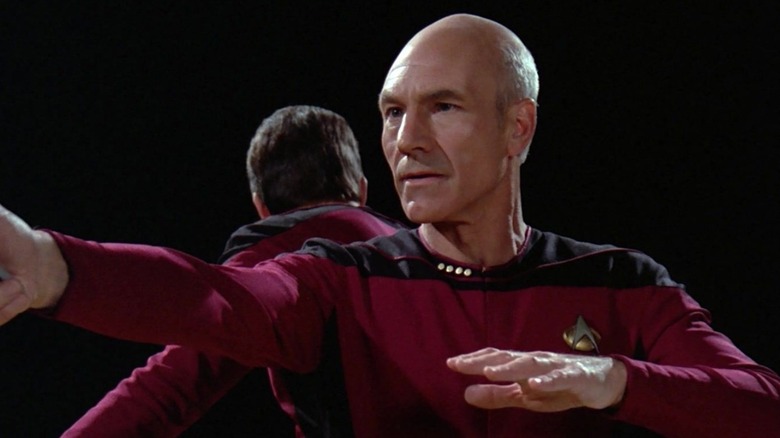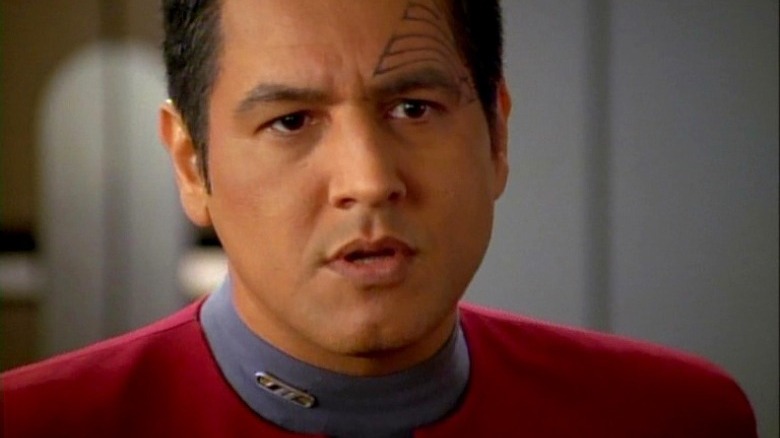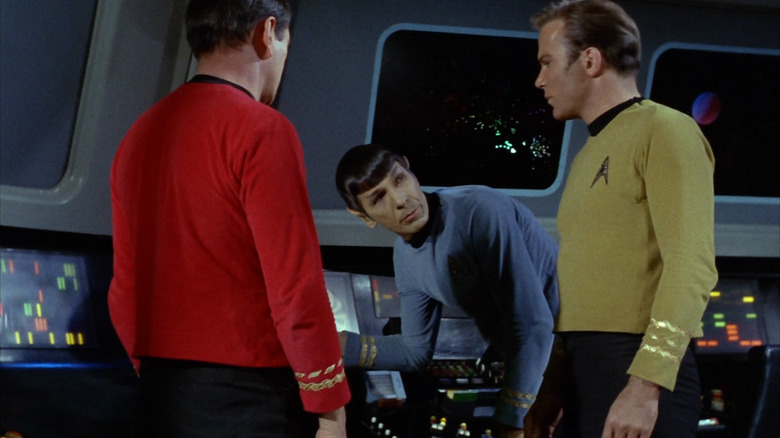How To Tell A Star Trek Character's Rank At A Glance: Rank Pips Explained
This post contains spoilers for the premiere of "Star Trek: Lower Decks" season 4.
At the beginning of the fourth season of "Star Trek: Lower Decks," the four main characters Boimler (Jack Quaid), Mariner (Tawny Newsome), Tendi (Noël Wells), and Rutherford (Eugene Cordero) are each promoted from the lowly rank of ensign to the only slightly-less-lowly rank of lieutenant junior grade. They still don't have much clout on the U.S.S. Cerritos, but at least now they no longer have to sleep in a hallway. One can see their promotions right away as, on their collars, they wear one solid pip and one empty pip. That, any Trekkie will instantly tell you, is the configuration for a lieutenant junior grade.
It should be noted that "Star Trek" has, since its inception, used extant naval ranks to designate Starfleet officers. Just like in the real United States Navy, officers start at the rank of ensign, then work their way up through lieutenant junior grade, then lieutenant, then lieutenant commander, then commander, then captain, before moving into the various ranks of admiral. "Star Trek" often makes reference to admirals and sometimes vice-admirals. There is also an occasional fleet admiral, the highest rank in both the Navy and in Starfleet. "Star Trek," to my recollection, has never referred to a real admiral, either lower half or upper half. Perhaps by the 22nd century, those ranks will be abandoned.
To command a starship, one typically has to bear the rank of captain, as we know from Kirk, Picard, Sisko, Janeway, Archer, Freeman, Pike, etc. Although it is not a requirement, a starship's first officer traditionally holds the rank of commander (Riker, Chakotay, Ransom, etc.).
We're going to do a deep dive into Starfleet ranking, so strap in for some extremely nerdy deep cuts.
The pips
The pips ranking system on "Star Trek" wasn't adopted until the days of "Next Generation," but they are the clearest, so it's a good place to start when educating one's self on Starfleet's chain of command.
Petty officers wear one empty pip on a starship. These are the enlisted members who didn't attend Starfleet Academy. Engineers, security personnel, yeomen, and the like are petty officers and take orders from the lowest-ranking Academy graduate officers on the ship. If one looks into expanded universe lore, one can find a hierarchy of Starfleet petty officers. There are master petty officers at the top, chief petty officers directly underneath, and several ranks below them. Those ranks, however, are rarely discussed on "Star Trek."
As mentioned above, ensigns wear one full pip, as seen on Wesley Crusher's collar above. Lieutenants junior grade wear one full pip and one empty pip. Lieutenants wear two full pips, and lieutenant commanders wear two full pips and one empty pip.
Commanders wear three pips, because it is a difficult rank to achieve.
Captains wear four pips, and are typically given the promotion when they are put in command of a starship. It's understood that only one captain lives on a starship at any given time.
Admirals have their own ranking system, with solid pips surrounded by boxes.
Commodores (an honorary title) have one boxed pip, rear admirals have two, vice admirals have three, regular admirals have four, and fleet admirals have five. "Star Trek" only deals with admirals from time to time, however, and characters who achieve that rank are often presented as villainous or unduly ambitious; Trekkies have been trained to be suspicious of admirals.
Other rank insignias
The premise of "Star Trek: Voyager" took a single Federation starship and slung it clear across the galaxy with a group of rebel Maquis members on board. Rather than keep the Maquis in the brig for the 70 years it would take the U.S.S. Voyager to return to Earth, Captain Janeway (Kate Mulgrew) assigned them ranks and made them part of the crew. Because these characters had not been to Starfleet Academy, however, they were given only provisional field ranks, a status reflected in their rank pips.
One can see the rank of Chakotay (Robert Beltran) in the photo above. He wears an elongated, rounded-edged bar with diagonal stripes. The coloration on the stripes corresponds to the open and closed pips of more traditional ranks. One can be a provisional ensign all the way up to a provisional captain. It's understood that these ranks are temporary. On the latest season of "Star Trek: Lower Decks," the character of T'Lyn (Gabrielle Ruiz) bears a provisional rank as she is an exchange officer from a Vulcan ship.
In some alternate future timelines (and this is "Star Trek," so there are plenty of those), the franchise's costume designers moved the rank pips from uniform collars to the communicator badges on their chests. Rather than little circular pips, their badges bore one to four elongated stripes behind the familiar Starfleet delta symbol.
Trekkies caught onto the pip ranking system pretty quickly, and many of us learned all about naval ranks through "Star Trek." The original series, however, was a little more oblique about visual ranking systems. It used to be a code stitched onto officer's sleeves.
The history of rank insignias
In the picture above, one can see the way ranks used to work on the original "Star Trek." Captain Kirk (William Shatner) had no rank on his collar, but wavy golden stripes around his wrist. Looking around at the crew, one found the following system: ensigns had no stripes on their wrists, while lieutenants junior grade had single "dashed" stripes. Lieutenants had a single solid stripe, and lieutenant commanders had a solid stripe and a dashed stripe (as seen on Scotty above).
Commanders (see Spock) had two solid stripes and captains (see Kirk) had two solid stripes with a dashed stripe in between them. The stripes were gold, giving the uniforms a pleasingly garish touch.
The "Star Trek" movies made the ranking code even more oblique. Rather than deal with a series of easily readable pips or stripes, the uniforms seen in "Star Trek II" through "Star Trek VI" bore a formal over-the-shoulder strap that rested on the wearer's right shoulder. Whatever pin you saw affixed to that strap corresponded to the officer's rank. Sadly, there was no intuitive way to discern what that rank might be. Ensigns, for instance, wore a small v-shaped pin. Lieutenants junior grade wore two funnel-shaped pins. Lieutenants wore an hourglass-shaped pin, and lieutenant commanders wore an elongated pennant-like shape with a single stripe through it. Commanders wore the same shape but with two stripes. The captain got to be fancy and wore a pin with three stripes, but also a pair of pointy arrowhead-like symbols affixed to it.
Only deep-cut Trekkies can suss out the differences.
That ranking system is an aberration, though. In the early days of "Star Trek: Enterprise" and the latter days of "Star Trek: Picard," the pip system is solidly in place.



